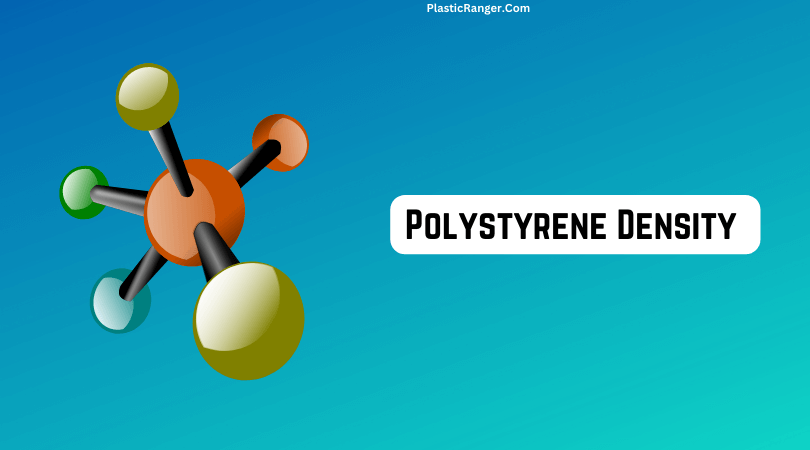A plastic material’s density is described as the mass per unit volume of a material, generally measured in grams per cubic centimeter (g/cm³) or kilograms per cubic meter (kg/m³).
Density of Polystyrene
Polystyrene density generally ranges from 0.96–1.05 g/cm3 and 28–34 kg/m3, depending on its molecular weight, crystallinity, and processing conditions.
The low density of polystyrene makes it a lightweight, convenient material to handle and transport. However, compared to higher-density plastics such as polyethylene and polypropylene, polystyrene’s lower density makes it less robust and more susceptible to damage or breakage.
Before delving into polystyrene density, it is essential to clarify the method for calculating the density of plastic materials.
What is Density?
Plastic density is a measure of the mass of a substance per unit volume. It is a fundamental physical property that can identify a material and determine its behavior under different conditions.
The density of a material can be expressed in units of grams per cubic centimeter (g/cm³) or kilograms per cubic meter (kg/m³).
Factors Affecting Polystyrene/Styrofoam Density
The density of any plastic material, let alone polystyrene, can be impacted by many factors, but I have mentioned the most common ones below.
Molecular Weight
The molecular weight and structure of polystyrene, which refers to the mass of its polymer chains, is a crucial factor that significantly impacts its density and other properties.
Polystyrene comprises lengthy chains of styrene monomers connected through a process known as polymerization.
The molecular weight of polystyrene is contingent upon the length of these chains, and it plays a vital role in influencing the density of the material.
When the molecular weight of polystyrene increases, the density of the material also rises correspondingly. This is because longer chains of polystyrene molecules can tightly pack together, increasing the mass per unit volume. Conversely, polystyrene with lower molecular weight exhibits shorter chains, leading to lower density.
Level of Crystallinity
The density of polystyrene is profoundly influenced by its degree of crystallinity, which refers to the extent of order in which the polymer chains are arranged.
Greater levels of crystallinity in a material result in tighter molecular packing and a consequent increase in density.
Polystyrene exhibits a relatively lower degree of crystallinity, leading to a comparatively disorganized polymer chain arrangement and a consequent decrease in density.
Nevertheless, adding specific additives, such as nucleating agents, can enhance the degree of crystallinity in polystyrene, boosting its density.
Processing Conditions
The density of polystyrene can also be influenced by the processing conditions implemented during its production.
The manufacturing process of polystyrene involves polymerizing styrene monomers to form extended chains of polystyrene molecules.
The technique employed to execute this polymerization reaction can impact the density of the resulting material.
For instance, suspension polymerization is the most commonly used method to produce polystyrene. It entails dissolving styrene monomers in water and adding a suspension agent to prevent them from aggregating.
The monomer mixture is then heated and stirred to trigger polymerization, forming tiny polystyrene beads. The size of these beads can affect the density of the polystyrene, with smaller beads resulting in higher density.
How Polystyrene Density Affects its Other Properties
The impact of polystyrene density is most evident in its mechanical properties. Typically, polystyrene with higher density exhibits greater strength and durability than those with lower density.
This is attributed to the tightly packed polymer chains in high-density polystyrene that generate stronger intermolecular forces, thereby increasing the material’s mechanical strength.
As a result, high-density polystyrene is the preferred choice in applications that require greater strength, such as packaging.
The thermal properties of polystyrene are also significantly impacted by its density.
Typically, higher density polystyrene exhibits better thermal stability than its lower density counterparts, primarily due to the closer packing of polymer chains.
The higher density improves the ability to withstand higher temperatures before melting or degrading, making high-density polystyrene an excellent choice for applications that require exposure to high temperatures, such as hot beverage cups.
Polystyrene density has a significant impact on its chemical resistance. The resistance of polystyrene to chemicals depends on the density of the material.
Higher density polystyrene has greater resistance to solvents and other chemicals because its tightly packed polymer chains prevent the penetration of chemicals.
On the other hand, lower density polystyrene is more susceptible to chemical attacks, which can cause degradation and a loss of properties.
Therefore, high-density polystyrene is typically the preferred choice for applications that require chemical resistance, such as laboratory equipment.
The density of polystyrene has a significant impact on its optical properties, including its transparency and refractive index.
Polystyrene with higher density typically has a higher refractive index, which means it can bend light to a greater extent.
This property makes high-density polystyrene well-suited for applications requiring efficient light reflection and refraction, such as optical fibers and lenses.
Furthermore, polystyrene’s density also affects its ease of processing. Lower density polystyrene is generally easier to process and mold than higher density polystyrene, as it requires less energy and effort to flow and form into the desired shape.
This makes lower density polystyrene ideal for manufacturing applications where ease of processing is essential, such as in injection molding.
Final Outcome
The density of polystyrene is a critical physical property that can be affected by various factors, including its molecular weight, level of crystallinity, and processing conditions. Understanding how these factors influence polystyrene’s density can help select the appropriate material for different applications.
For example, higher density polystyrene may be preferred for applications with increased strength, while lower density polystyrene may be preferred for applications where weight reduction is essential.
Quick Navigation

